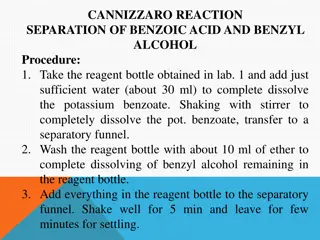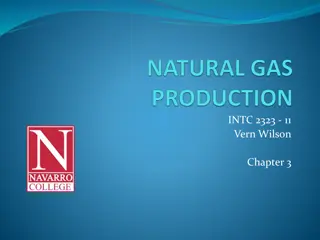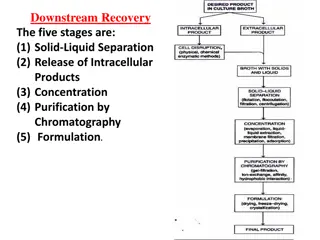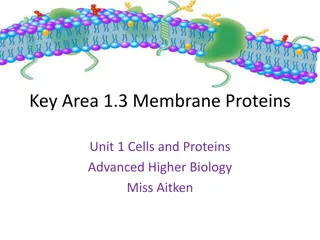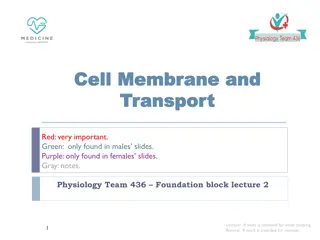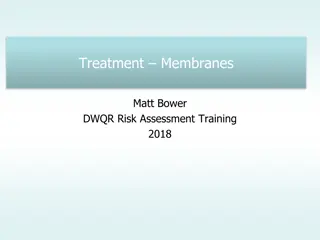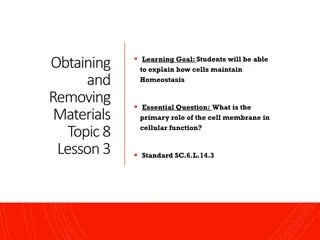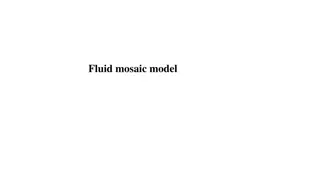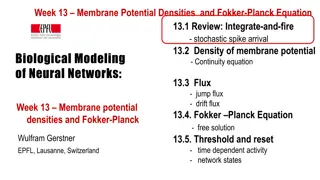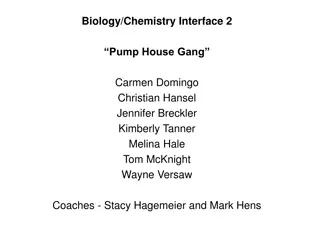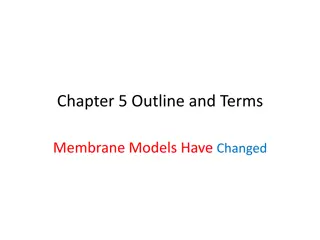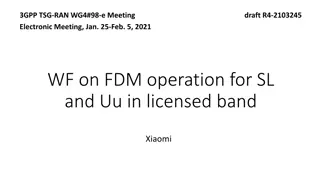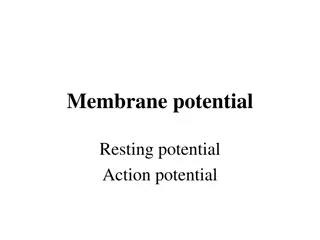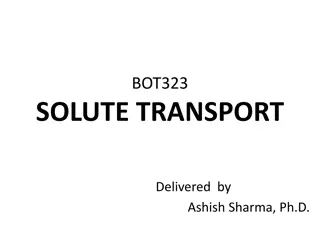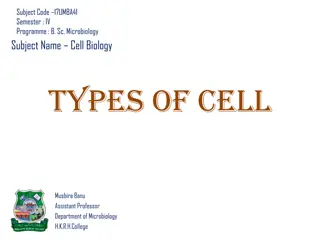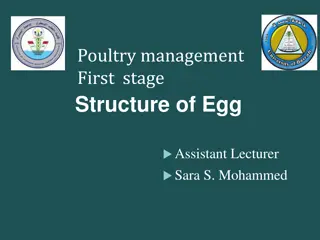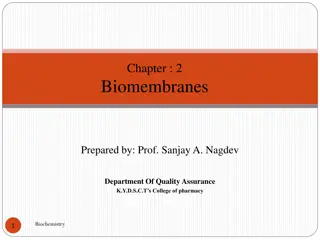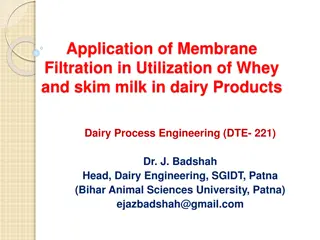Introduction to Membrane Separation Processes
Membrane separation processes utilize semi-permeable membranes to selectively separate molecules based on size, affinity, or charge. This natural phenomenon offers advantages such as continuous separation and low energy requirements, although fouling can be a concern. Learn about the types of membranes, driving forces, advantages, disadvantages, and industrial classification of membrane processes.
Download Presentation

Please find below an Image/Link to download the presentation.
The content on the website is provided AS IS for your information and personal use only. It may not be sold, licensed, or shared on other websites without obtaining consent from the author.If you encounter any issues during the download, it is possible that the publisher has removed the file from their server.
You are allowed to download the files provided on this website for personal or commercial use, subject to the condition that they are used lawfully. All files are the property of their respective owners.
The content on the website is provided AS IS for your information and personal use only. It may not be sold, licensed, or shared on other websites without obtaining consent from the author.
E N D
Presentation Transcript
Membrane Separation Processes
What is Membrane? Membranes are materials which have voids in them, letting some molecules pass more conveniently than some other molecules. A semi-permeable membrane is a VERY THIN film that allows some types of matter to pass through while leaving others behind
Membrane separation processes are used for separation that is difficult to be carried outin a classical separation such as sedimentation, filtration, or centrifuge. Typical cases are: Finely dispersed solids Solids which have a density close to that of the liquid phase Solids which have gelatinous nature Low molecular weight and non-volatile organics Pharmaceuticals Dissolved salts Sensitive biological materials Membrane separation is a natural phenomenon to separate active materials biologically.
Membranes are materials which have voids in them letting some molecules pass more conveniently than some other. How separation occurs? Difference in permeabilities through a membrane: Difference in size, Affinity to the membrane, Charge, etc. Driving forces Pressure difference, Concentration difference Voltage difference, etc
Advantages of Membrane Separation Continuous separation Low energy requirement Meet variousseparation demands Disadvantages Fouling Short service periods
Classification of Membrane Processes Industrial membrane processes may be classified according to the size range of materials which they are to separate and the driving force used in separation. The most common pressure driven membrane separation processes classified according to pore size are: Microfiltration (MF) filtration of suspensions with micro scale particles Ultrafiltration (UF) - paint plants in the car industry, dairy industry Nanofiltration (NF) - pharmaceutical processing and water treatment Reverse osmosis (RO) desalination of brackish and sea water, dairy industry See Table 8.1 for the classification of membrane processes
Membrane Materials Cellulosic membrane Polyamide membrane Polysulphone membrane Polycarbonate membrane Reverse Osmosis Only remove some suspended materials larger than 1 micron The process eliminates the dissolved solids, bacteria, viruses and other germs contained in the water Only water molecules allowed to pass via very big pressure Asymmetric type membranes (decrease the driving pressure of the flux) Almost allmembranes are made polymers, cellulosic acetate and matic polyamide types rated at 96%-99+% NaCl rejection
Extensive Applications: Potable water from sea or brackish water Ultrapure water for food processing and electronic industries Pharmaceutical grade water Water for chemical, pulp & paper industry Waste treatment Future Directions: Municipal and industrial waste treatment Process water for boilers De-watering of feed streams Processing high temperature feed- streams
Microfiltration Largest pores A sterile filtration with pores 0.1-10.0 microns Micro-organisms cannot pass through them Operated at low pressure differences Used to filter particles. May or may not be asymmetric
Wide array of applications: Sterile water for pharmaceutical industry Food & beverages Chemical industry Microelectronics industry Fermentation Laboratory/analytical uses Applications in the near future: Biotechnology (concentration of biomass) Diatomaceous earth displacement (Diatomaceous earth is a filter media used for the same purposes but needs periodic replacement) Non-sewage waste treatment (removing intractable particles in oily fluids) Paints (separating solvents from pigments)
Ultrafiltration To separate a solution; mixture of desirable and undesirable components Has smaller pores than microfiltration membranes Driving force pressure differential (2-10 bars to 25-30 bars) Used to separate species with pore sizes 10-1000 (10-3-0.1 microns) Can be obtained down to a molecular weight cutoff (MWCO) level of 1000 and up to as high as 1 000 000. Aasymmetric; the pores are small Wide range of applications : Oil emulsion waste treatment Treatment of whey in dairy industries Concentration of biological macromolecules Concentration of textile sizing Concentration of heat sensitive proteins for food additives
Wide range of applications in the near future: Ultrafiltration of milk Bioprocessing (separation and concentration of biologically active components) Protein harvesting (production of protein on field) Refining of oils Nanofiltration Less pore sizes than ultrafiltration membranes The mass transfer mechanismis diffusion& separate small molecules from the solution (asymmetric) Cellulosic acetate and aromatic polyamide type membranes (salt rejections; 95% for divalent salts to 40% for monovalent salts) Can typically operate at higher recoveries; conserving total water usage due to a lower concentrate stream flow rate (advantage over reverse osmosis) Not effective on small molecular weight organics (e.g.methanol)
Typical applications: Desalination of food, dairy and beverage products or byproducts Desalination of whey, UF permeate or retentate as required Desalination of dyes and optical brighteners Purification of spent clean-in-place (CIP) chemicals Color reduction or manipulation of food products Concentration of food, dairy and beverage products or byproducts Membrane Process Characteristics
General Membrane Equation The general membrane equation takes the form: R R P = J ( ) + m c Where J is the membrane flux, expressed as volumetric rate per unit area Rm is the resistance of the membrane. Rc is the resistance of layers deposited on the membrane, the filter cake and gel foulants. Is the difference in osmotic pressure across the membrane. (trans membrane pressure). P is the pressure difference applied across the membrane
If the membrane is only exposed to pure solvent, say water, then the above equation reduces to R P J = m It is clear that the trans membrane pressure must exceed the osmotic pressure for flow to occur. The separation of a solute by a membrane gives rise to an increased concentration of that solute at the membrane surface, an effect known as concentration polarization.
Cross-Flow Microfiltration The classical filtration processes are limited to concentrating particles above 5 m. For solutions with particles of less than 5 m down to 0.1 m, the suitable separation process is the microfiltration. It is necessary that the particles concentration is small in order not to clog the micro filter.
A flow diagram of a simple cross-flow system is shown in the figure below
The feed is pumped at a velocity in the range 18 m/s parallel to the face of the membrane and with a pressure difference of 1 5kPa/m2 across the membrane. The liquid permeates through the membrane and the feed emerges in a more concentrated form at the exit of the module. See Fig. 8.5 of flow diagram for a simple cross-flow system and Fig. 8.6 for the variation of permeation flow with time. For microfiltration accompanied with fouling on the membrane the membrane flux can be written as R R + P = J ( ) m c Rc now represents the resistance of the cake, which if all filtered particles remain in the cake, may be written as: Where r is the specific resistance of the deposit V is the total volume filtered Vsis the volume of particles deposited Cbis the bulk concentration of particles in the feed (particle volume/feed volume) Amis the membrane area.
The specific resistance can be expressed as where e is the void volume of the cake and ds the mean particle diameter. Combining the above equations gives Solution of the above equation for V at constant pressure gives: Yielding a straight line on plotting t/V against V


